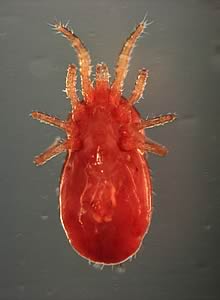 |
|||||||||
|
|||||||||||||||||||
|
|
Red
Mites Potential Source of Salmonella Transmission 02/04/08 Red mites, which are difficult to eradicate as they shelter in cracks and crevices in poultry houses during the day, are a potential source of salmonella transmission, according to biosecurity experts at agriculture specialists Kiotechagil.
Mites, both the red mite and the northern fowl mite have long been regarded as being one of the most common and critical problems for poultry farmers. They move quickly over a bird’s skin and feathers and their blood sucking activity can crucially cause a drop in egg production as well as anaemia and in the case of severe infestation – death. While red mites feed on the birds in darkness often for about 1-2 hours each night before retreating to the extremities of the poultry house, the northern fowl mite breeds continually on the bird and it is therefore a particular problem for caged birds. Mite detection is best achieved by monitoring if any increase in food consumption is accompanied by a decrease in egg production. This will be caused by the chickens needing to replace the lost blood taken by the mites reducing the energy available for egg laying. Additionally, poultry owners should look under slats both in nests and in cracks in the house structure to see if mites are evident as tiny red to blackish dots - often in clusters. Finally, if infested with the Northern Fowl mite, the chickens will often start to peck each other where they see infestation, usually at the base of a bird’s tail feathers “Because red mites can live away from birds for up to six months they are frequently extremely difficult to get rid of,” says Kiotechagil’s Mike Rogers. In addition, the largely mild winters of the last few years has enabled the mites to survive and thrive.” Recommended treatments to eradicate mites include thorough cleaning the chicken accommodation and using products such as MiteX, a natural non chemical insecticide which can be used in poultry houses and in feed storage areas without risk to the birds, feed or any workers. The MiteX powder, which has extremely high oil absorption, is highly effective at attaching itself to and then lacerating the waxy surface of the insect as they move through it.
|
||||||||||||||||||

|
|
||||||||||||||||||
| home | agri-services | pedigree
pen | news | dairy | beef | machinery property | organisations | site map |
|||||||||||||||||||
